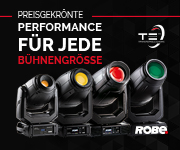Aktuelle News & Schlagzeilen
Funicular Goats creates cinematic multi-camera production workflows with AJA gear
Funicular Goats’ projects include concert productions, the annual big game halftime show, comedy specials, and more. The company embeds itself in every project from beginning to end, using a cinematic multi-camera workflow as a starting point, which includes all the standard tech for moving signals throughout the chain and live grading - including AJA equipment.
Typically, producers reach out to Funicular Goats directly regarding projects, but the company also receives inquiries from tech managers, directors, and DPs. Its team works closely with all key project stakeholders to plan a multi-camera workflow design, and the encompassing tech - including cameras, comms, the engineering fly pack, wireless systems for the cameras, transmission (digital, broadcast, or satellite) fiber infrastructure, and on-set monitoring solutions. Projects average 10-20 cameras per show, but the team has worked on projects involving up to more than thirty cameras.
Across productions, Funicular Goats must manage different elements and workflow refinement, but ninety percent of the time, the project demands live grading, which means AJA FS-HDR real-time HDR/WCG converters are on set. Running a camera log feed through the FS-HDR allows the team to achieve a more comprehensive range of RGB to build a better look than using just an RCP camera control alone.
“Productions are often looking for ways to execute their projects but aren’t certain how to do it, so they lean on us. We advise them on how to make it happen and help them achieve the look they’re aiming for in the most efficient way”, says Funicular Goats co-founder Morgan Kellum. Projects typically require SDR delivery, but Funicular Goats is seeing HDR requests grow, especially for concert productions and larger scale event broadcasts.
FS-HDR supports conversion needs across Funicular Goat projects. The team may need to use it to help step down a 12G-SDI or 6G-SDI feed from a cinema camera to 1080 for viewing, as well as for coloring and recording. The device also enables frame rate conversion, which the team will leverage when moving from 24p to a broadcast standard for a truck workflow. They might bring back a log feed 23.98p that will hit their distribution amplifier (DA) and into a switcher where they cut 23p. Out of the DA, that feed might go to the FS-HDR, where they can then go 29.9p and elsewhere with it to a line cut, and cut 29.97p for broadcast.
In addition to live grading, recording is essential to Funicular Goats’ workflow designs. The team often completes 4K recordings with a cinema camera, with a 1080 workflow out for a reference line for added flexibility. If delivering a 1080 project, they’ll record the loaded or color corrected 1080 files to AJA Ki Pro Ultra 12G ProRes and DNx recorders/players. This approach ensures they have a master finish of the project as well as the 4K log footage to work with.
If footage is already color corrected, Funicular Goats can do an online cleanup with those files or edit with them as well. They may opt to use Ki Pro Ultra 12G as a quad HD recorder for four 1080 feeds on one project, or for backup 1080 recordings, ISOs of the cameras, or to create multiple copies of a program or multiple views on others.
Sometimes, they’ll do a 6G-SDI or 12G-SDI into the Ki Pro Ultra 12G. When they need to hand off thumb drives with H.264 recordings after an event, they often use AJA Ki Pro Go. “We also use of a ton of other AJA products - everything from the Kumo 3232-12G routers, to the 12GDA and Hi5 Mini-Converters, throw down distribution amplifiers, and FS2 frame syncs”, adds Kellum.
For the big game halftime show earlier this year, Funicular Goats captured 29.97p from Sony Venice 2 cameras. The feeds were sent to its production truck with an AJA Kumo 3232-12G router on-board. The feeds hit their distribution amplifiers first, and were then sent through the router and Funicular Goats’ twelve FS-HDRs, as well as through sixteen additional FS-HDRs on site, and then into the switcher and out for broadcast distribution. The FS-HDRs enabled the DIT crew to work with the log and HDR feeds and bounce them back and forth while also supporting frame syncing to lock all feeds with the main program audio.
SCHLAGZEILEN
news archiv
suche
© 1999 - 2025 Entertainment Technology Press Limited News Stories







